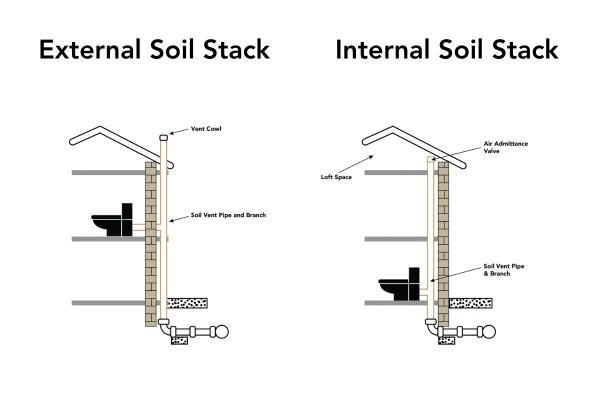What is a Soil Pipe and How do They Work?
In both residential and commercial properties, there are a variety of facilities that might generate wastewater.
Wastewater is directed away from the premises and into a mains sewer system via a network of pipes. The smaller of these pipes are generally termed as waste pipes, these generally run mainly with a small horizontal gradient. When these waste pipes turn and run vertically they are generally called soil pipes. These waste and soil pipes remove soiled water from toilets and urinals, sinks, baths, showers, washing machines etc. Wastewater can be considered as ‘black’ for such waste as toilets and urinals, and grey for other waste.
It is common for grey and black water to leave the property through a common soil pipe. When the soil pipe enters the ground it turns through 90 degrees, and heads off towards the main sewer through the drainage system. Larger buildings may have a network of soil pipes serving different floors and different areas of the buildings.
The Basics
In the UK, Building Regulations are enforced by local authorities or approved inspectors. For soil pipe regulations, they are generally covered under Part H (Drainage and Waste Disposal) of the Building Regulations in England and Wales. If you’re responsible for maintaining a commercial building, a social housing property, a hotel or a retail space, ensuring the soil pipe is clean and well maintained is key to avoiding costly and inconvenient blockages. There are additional considerations related to soil pipes in the UK, too.
Design and Installation
Soil pipes should be designed and installed in accordance with the relevant British Standards, such as BS EN 12056 for gravity drainage systems inside buildings. The design should consider factors like pipe diameter, gradient, and ventilation to ensure proper drainage.
Soil pipe regulations state that the top of the soil pipe should always be above the highest water inlet into the pipe, and that the top of the soil pipe should be adequately vented. Venting can be inside a building through an air admittance valve, or external by venting to atmosphere. The soil pipes installed need to be large enough for soiled water and waste to pass to the sewer. They are usually 110mm in diameter for ground soil systems, or 160mm in diameter for high buildings.
There are two ways that a soil stack can be installed, they can either run internally or externally and both have their benefits. Internal stack pipes are more aesthetic as they are hidden within walls, this also protects them from the elements and helps prevent them freezing in cold weather. However, they can be difficult to access in the event of a blockage or repair. External soil stacks on the other hand are much easier to access as they are installed on the outside of buildings, however, they can be seen as an eye sore and are vulnerable to the elements which can cause issues.

Material
Soil pipes should be made of durable and corrosion-resistant materials. Today, PVC and ductile iron are favoured over the traditional cast iron used in older properties.
PVC is lightweight and flexible, while being resistant to chemicals and is the cheaper of the modern materials. Typically, they are also available in longer lengths meaning fewer joints are needed to connect a system. Joints and connections must be watertight and comply with the relevant standards.
Ventilation
Adequate ventilation is crucial for a drainage system to function correctly. This includes providing ventilation pipes or other approved methods to prevent the build up of foul air.
New soil and vent pipes which connect kitchen fittings to drains must be adequately ventilated.
Access and Inspection
The system should include access points for inspection and maintenance purposes, such as rodding eyes or access chambers.
Building Control Approval
The installation of soil pipes and drainage systems may require approval from the local Building Control authority or an approved inspector. This ensures compliance with the relevant regulations. It’s essential to consult the specific Building Regulations and codes applicable to your location, as they may have been updated recently. Local authorities or Building Control bodies can provide the most accurate and up-to-date information for your area.
How Metro Rod Can Help
Metro Rod can assist with ensuring that soil pipes are in line with UK regulations, ensuring that your drainage meets all the regulations and is designed and installed correctly. When you need assistance, Metro Rod is on-hand 24/7, 365 days of the year, across the UK to offer a range of soil pipe cleaning services.

Talk to your local Metro Rod specialist
We are always happy to arrange a free site assessment and no obligation quotations for any work you might need. Alternatively, you can call our emergency hotline number on 0800 66 88 00
Get in touch Drainage Services